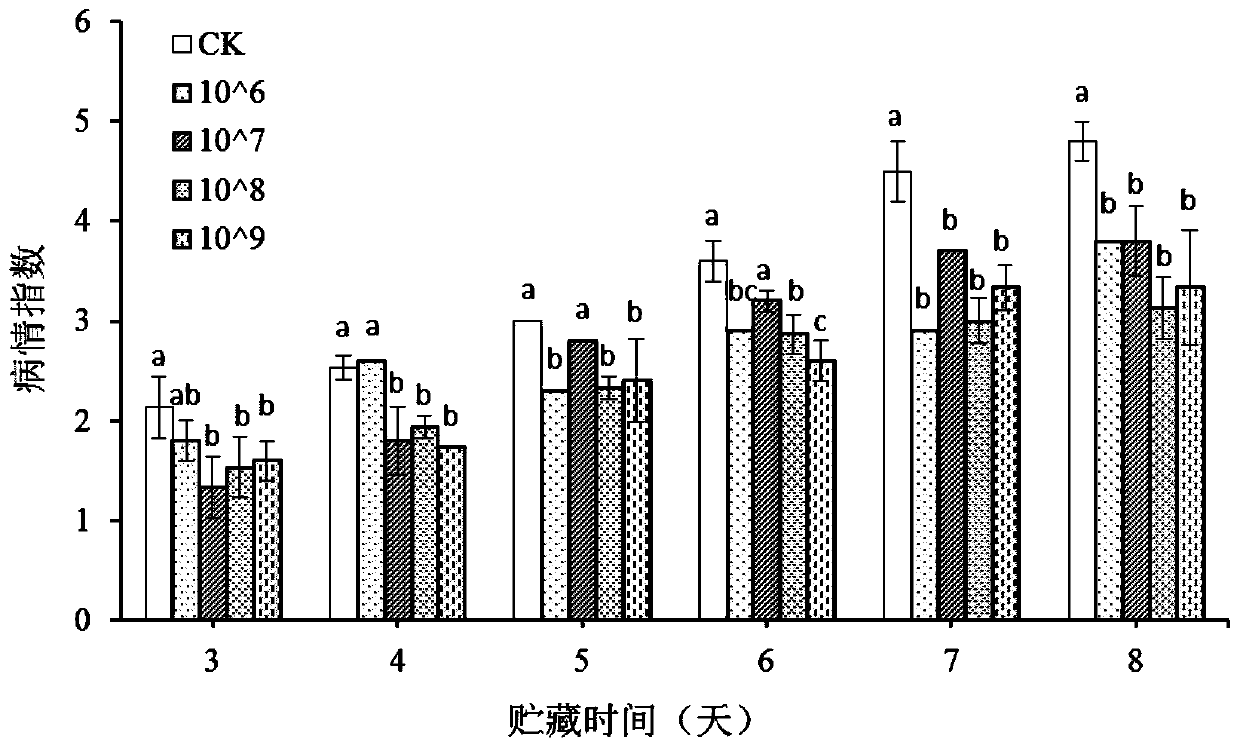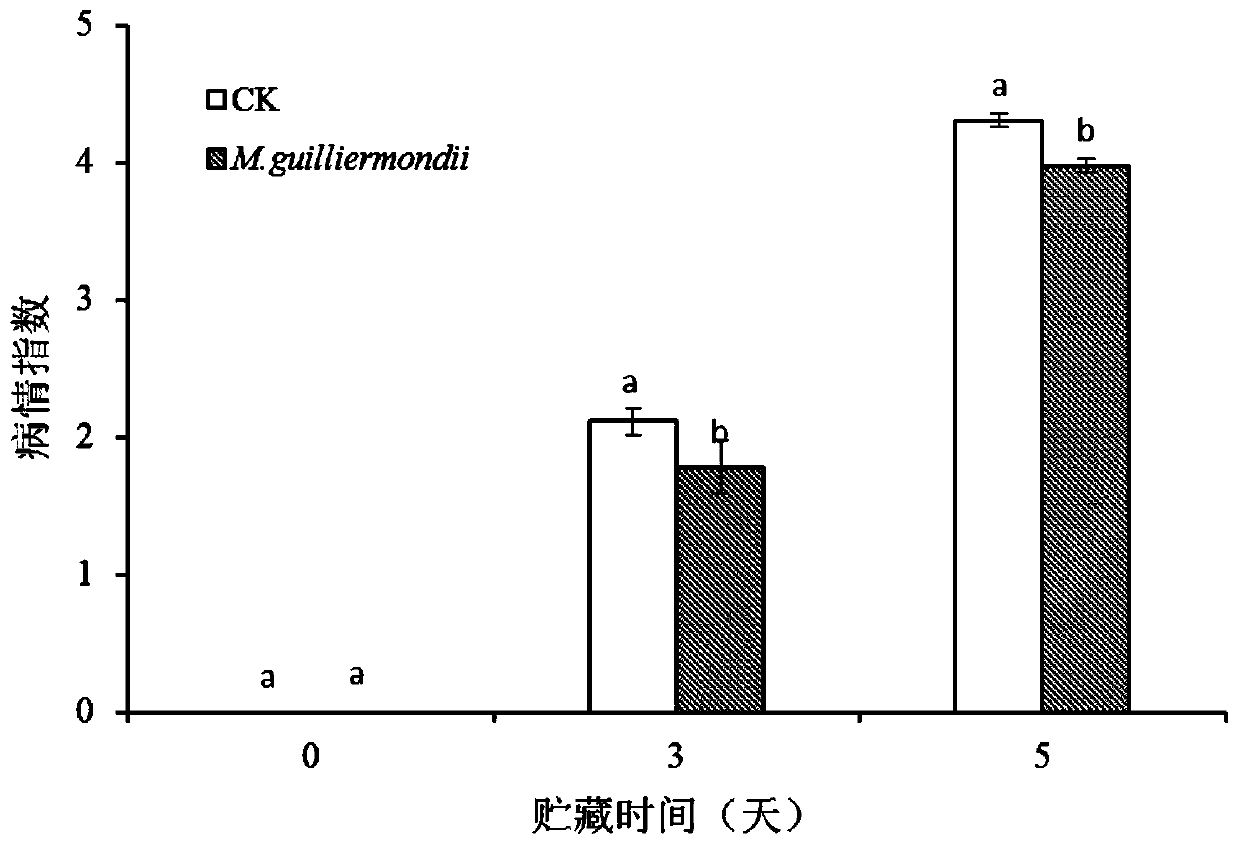Method for controlling postharvest diseases of broccoli and storing and preserving broccoli by using Meyerozyma guilliermondii
A post-harvest disease, storage and preservation technology, applied in the fields of chemicals for biological control, microorganism-based methods, and fruit and vegetable preservation, etc., can solve the problems of less yeast and lower rot index, etc. The effect of quality degradation and loss reduction
- Summary
- Abstract
- Description
- Claims
- Application Information
AI Technical Summary
Problems solved by technology
Method used
Image
Examples
Embodiment 1
[0034] The microbiological characteristics of the Y1 strain are as follows:
[0035] 1) Morphological features
[0036] (1) NYDA medium (beef extract 8g, yeast extract 5g, glucose 10g, agar 20g, 115°C damp heat sterilization for 20min) cultured at 28°C for 48h, the colony was round, milky white, slightly raised, with smooth edges and relatively moist , Easy to provoke. The cell shape is oval or oval, with budding at one or both ends.
[0037] (2) After being cultured in NYDB liquid medium for 24 hours, the bacterial solution was turbid, precipitated and had a special smell.
[0038] 2) Molecular biological identification
[0039] The 5.8S rDNA-ITS region sequence of the isolated and screened yeast strain Y1 was analyzed, searched in NCBI, and identified as Meyerozyma guilliermondii. According to the retrieved homologous strains, the MEGA7 software was used to construct a biological evolutionary tree such as figure 1 shown.
[0040] The antagonistic yeast strain Y1 of pre...
Embodiment 2
[0042] Safety Experiment of Ji Yemeng Yeast Y1
[0043] 1) Experimental scheme
[0044] Preparation of yeast puree:
[0045] The liquid culture solution of Quinillemos yeast Y1 in NYDB was centrifuged and washed twice with sterile normal saline to obtain the sludge, and then diluted with sterile normal saline to the required concentration. Each time the mice were gavaged with bacteria solution, they were diluted with fresh bacteria sludge.
[0046] The test species is ICR mice, which were purchased from the Animal Experiment Center of Jiangsu University with the certificate number No. 201613561, the license number SCXK (Su) 2013-0011, and the implementation standard GB15193.3-1994. Select 40 clean-grade ICR mice with body weight ranging from 18g to 22g, half male and half male. Before the test, the mice were placed in the animal experiment center to be fed normally for 3 days, and fasted for 4 hours before the test. The mice were divided into 4 groups, 10 in each group, 5 m...
Embodiment 3
[0053] Screening of Jiyemeng Yeast Y1 Concentration for Controlling Postharvest Diseases of Broccoli
[0054] 1. Test plan
[0055] Select broccoli with uniform color and no mechanical damage or pest damage on the surface. First, rinse the soil and impurities on the surface of the broccoli with clean water, and then process them into small flowers of uniform size. After drying naturally, use 75% Spray the surface with alcohol so that it is completely covered by alcohol for 1 minute for sterilization. After the end, rinse it with clean water and put it in an ultra-clean workbench to dry. Use 1×10 6 cells / mL, 1×10 7 cells / mL, 1×10 8 cells / mL, 1×10 9 cells / mL concentration of Jiyemeng's yeast Y1 and sterile saline were sprayed on the surface of broccoli, and after 2 hours, 30 μL of 1×10 5 spores / mL of pathogen spore suspension. After drying naturally, put the broccoli into a sterilized lunch box, seal it with a sterilized and dried eight-layer gauze, store it in a constant ...
PUM
 Login to View More
Login to View More Abstract
Description
Claims
Application Information
 Login to View More
Login to View More - R&D
- Intellectual Property
- Life Sciences
- Materials
- Tech Scout
- Unparalleled Data Quality
- Higher Quality Content
- 60% Fewer Hallucinations
Browse by: Latest US Patents, China's latest patents, Technical Efficacy Thesaurus, Application Domain, Technology Topic, Popular Technical Reports.
© 2025 PatSnap. All rights reserved.Legal|Privacy policy|Modern Slavery Act Transparency Statement|Sitemap|About US| Contact US: help@patsnap.com



